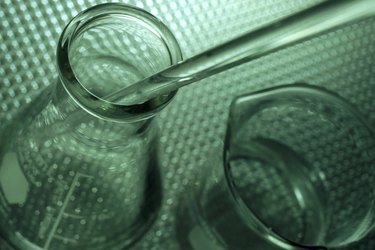
Simple sugars, also referred to as monosaccharides, are the basic unit of carbohydrates. Unlike sucrose, which is made of both a glucose and fructose sugar molecule, a simple sugar is either glucose or fructose respectively. Complex sugars, or polysaccharides, are present in foods like vegetables and whole grains. You can test for these simple sugars in your foods by using Benedict's reagent, a solution made of copper sulfate and sodium hydroxide. You can purchase this solution in a drug store as it used to indicate the presence of sugar in the urine of diabetics.
Step 1
Turn on your hot plate to medium heat and place your beaker filled with 100 mL of water on it. Bring it to a boil.
Video of the Day
Step 2
Pour 4 mL of your food sample in a test tube if it is liquid based. If you are testing a solid food, you can use a food processor to puree it by adding a small amount of water or crush the item into a powder using a mortar and pestle. Add water to the powder and pour it in the test tube.
Step 3
Add approximately 1 mL of Benedict's solution to the test tube using a dropper. Slowly swirl the test tube counterclockwise to distribute the reagent evenly.
Step 4
Place your test tube into the beaker until you note a color change -- this process usually takes five minutes.
Step 5
Examine the color change, if it is present. Benedict's reagent has a color change gradient from blue, meaning no simple sugars are present, to green, yellow, orange, red and brown. The color sequence indicates the increasing concentration of the simple sugar, with green being the lowest and brown being the highest.
Things You'll Need
Benedict’s reagent
Beaker
Test tubes and holder
Graduated cyclinder
Food samples
Food processor
Water
Hot plate
Mortar and pestle
Dropper
Video of the Day